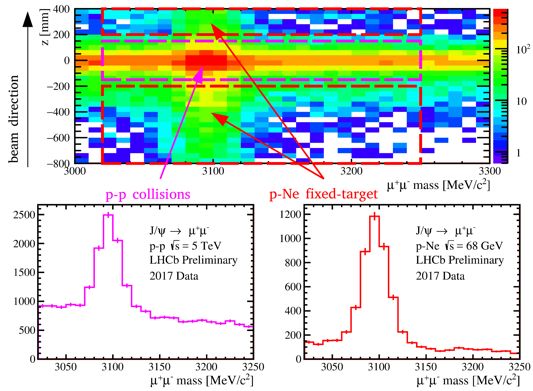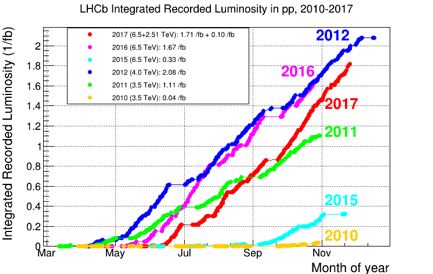End of data taking for 2017.
The 2017 data taking period ended this Sunday. Towards the end of the 2017 run at the centre-of-mass energy of 13 TeV, the LHC provided collisions at a reduced energy of 5 TeV to produce reference data for proton-lead and lead-lead collisions taken earlier in Run 2. Besides the scientific interest of proton-proton (p-p) physics at 5 TeV for the LHCb heavy-ion programme (see [1], [2]), the experiment has been taking at the same time a parallel stream of data from fixed-target collisions with another world first in high energy physics.
There have been typically 1836 bunches of protons circulating in each LHC ring, out of which 1094 collided inside the LHCb detector. LHCb physicists decided to use additional non-colliding bunches to accumulate the largest sample of proton-neon data in a fixed-target configuration. The LHCb experiment has the unique ability of injecting gas, neon in this case, into the interaction region and therefore study processes that would otherwise be inaccessible. This gas-injection system was originally designed to help LHCb measure the brightness of the accelerator’s beams, but is now being used for dedicated physics measurements. This kind of operation is called by physicists a “fixed-target” mode in contrast to the standard “collider” mode used at the LHC, as in this case the LHC protons are colliding with stationary neon nuclei.
It has been the first time ever that an experiment has collected data in the collider and fixed-target modes simultaneously. LHCb physicists showed that it is possible to reconstruct both sets of data in parallel, align the detector elements and track particle trajectories correctly. A real challenge has been to develop an online event selection (trigger) system handling efficiently both data taking conditions. The live images (left) obtained by the data acquisition computer programs show reconstructed μ+μ– invariant mass spectra. The J/ψ-meson peaks are clearly visible in the two different operational modes. The two-dimensional plot shows the z coordinate (along the proton beam direction) of the origin of the μ+μ– pair. A strong accumulation around z=0 indicates the p-p collision point. The pink-dashed rectangle highlights the regions were p-p collision events were selected. The two other (red-dashed) rectangles show the region where only p-Ne collisions take place.
LHCb continues to revolutionise data acquisition and analysis techniques. Already two years ago the concepts of “online” and “offline” analysis were unified. The calibration and alignment process takes place now automatically online and stored data are immediately available offline for physics analysis. This time the collider and fixed-target modes of operation have been unified into the same data acquisition framework. In particle physics, a grand-unified theory is one in which at very high energies the electromagnetic, weak and strong interactions unify as a single force. Today LHCb physicists have succeeded to unify very different concepts of data taking and analysis.
The 2017 data taking period has been very successful, because of the excellent performances of both the LHC and the LHCb experiment itself. The image shows the growth of integrated luminosity during different years of LHC operation. The 2017 integrated luminosity is higher than that collected in 2016. The overall Run 2 luminosity (2015-2017), 3.7 fb-1, is already higher than that recorded in Run 1 (3 fb-1, 2010-2012).
A traditional end-of-year shutdown period, so-called Year End Technical Stop (YETS), is starting now. It will be used for maintenance and improvements to the LHC and its detectors. LHCb plans to exploit this period to perform maintenance work on many sub-detectors. It is planned that protons will start to circulate again in the LHC rings at the beginning of April 2018 and that the first p-p collisions for physics will take place in early May, marking the beginning of the last year of Run 2. The two-year Long Shutdown 2 will then start in December 2018, and during this period the LHCb detector will face its first major upgrade, which will allow the experiment to take data at much higher rate.
Read more in the CERN update.


